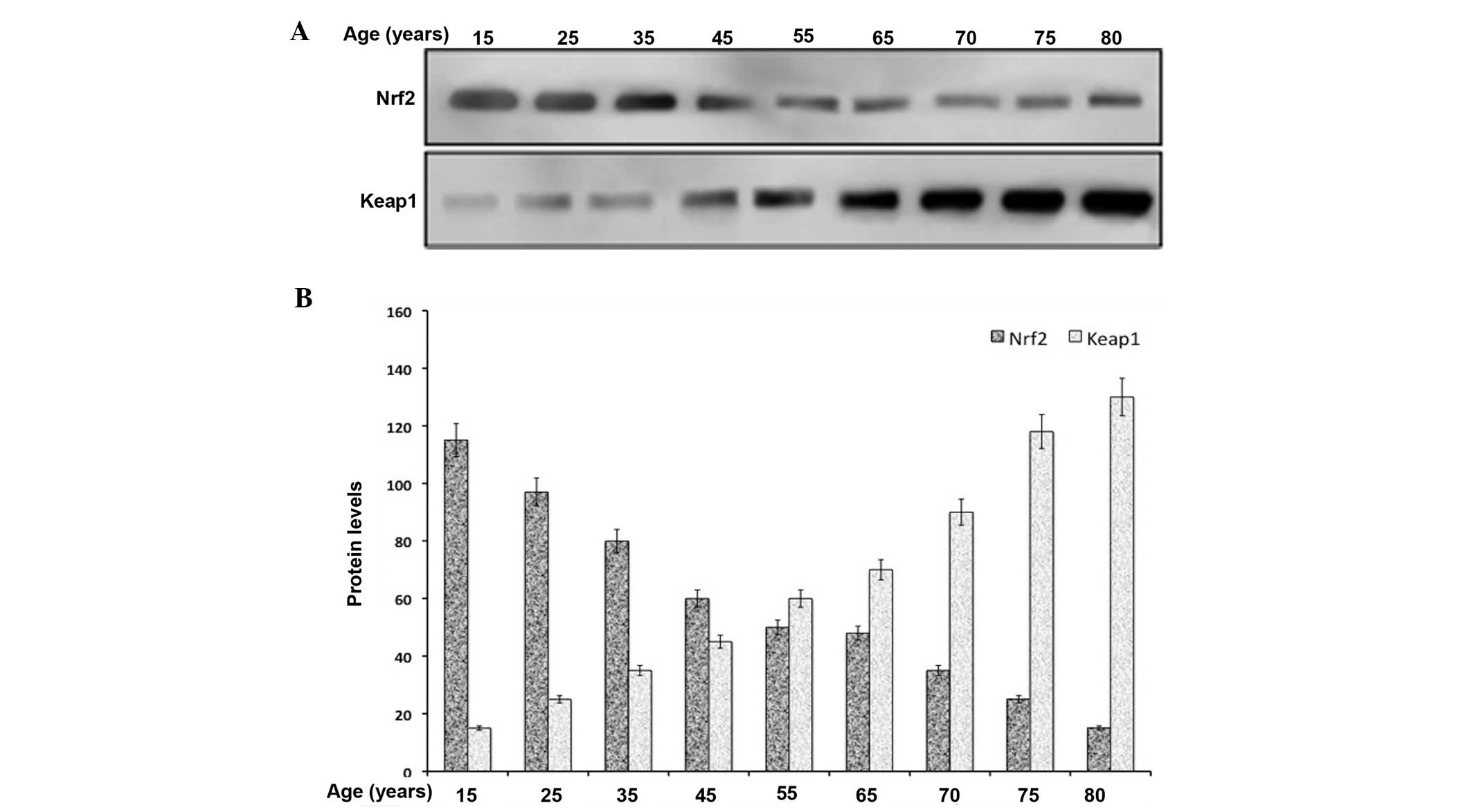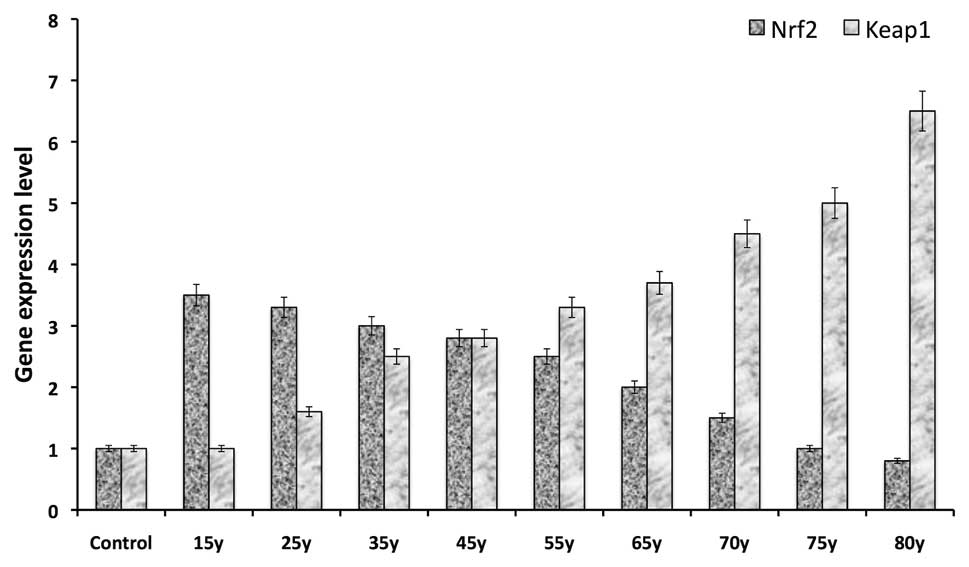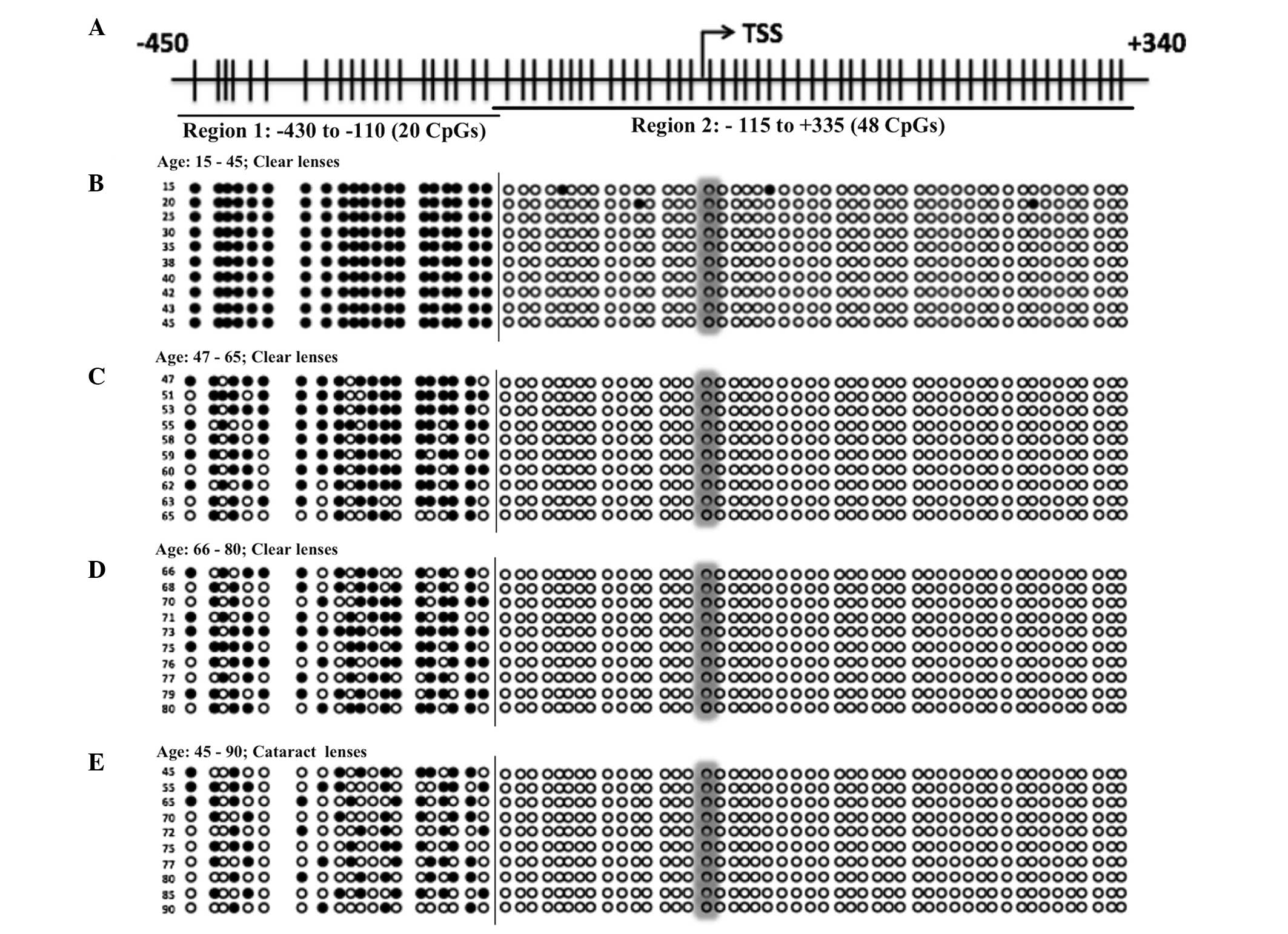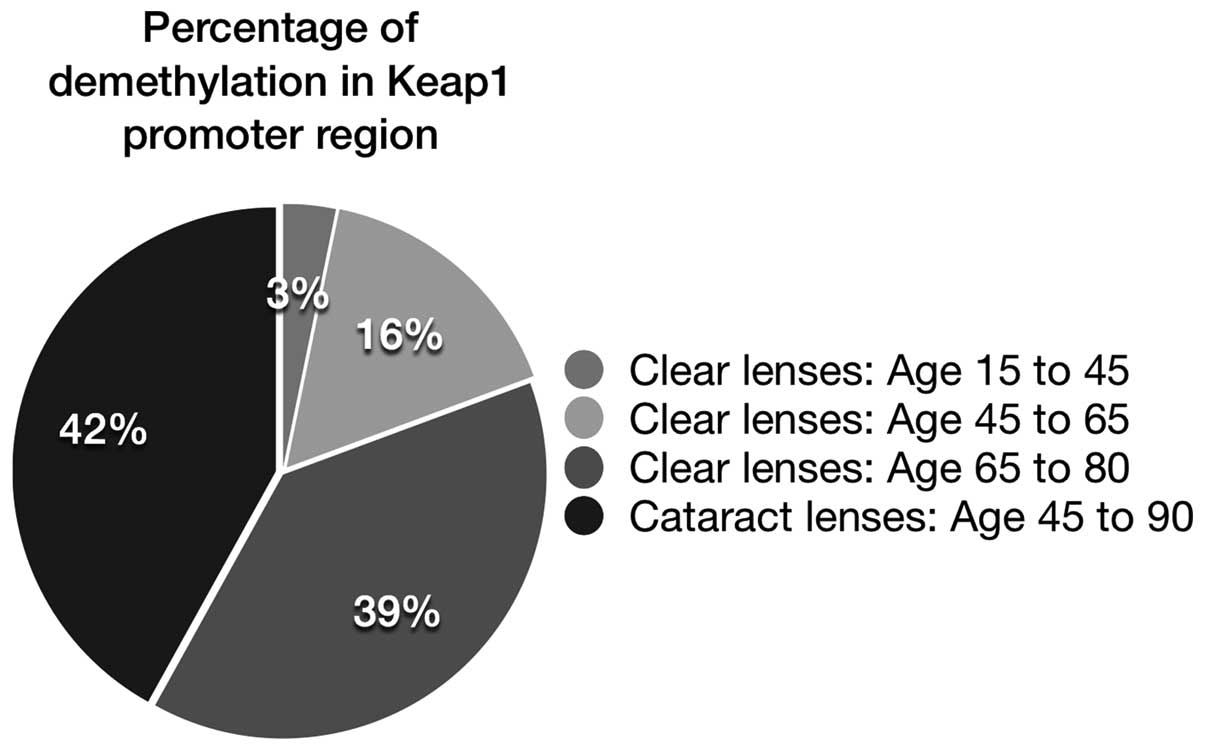Human age‑related cataracts: Epigenetic suppression of the nuclear factor erythroid 2‑related factor 2‑mediated antioxidant system
- Authors:
- Published online on: November 3, 2014 https://doi.org/10.3892/mmr.2014.2849
- Pages: 1442-1447
Abstract
Introduction
A study from the American Federation for Aging Research states that as normal cells become senescent, whether due to ongoing cell division, direct DNA damage, activated oncogenes or other causes, they incur hundreds of biological alterations that affect several of their activities (1). A number of these changes are similar, if not identical, to the types of changes that are observed in aging humans. It is hypothesized that the numerous losses in function that occur in cells as they approach senescence leads to an increased vulnerability to age-related diseases or pathologies. Therefore, the study of cellular senescence continues to provide important insights into the aging process at the level of the cell and the pathways within the cell.
An imbalance in antioxidants and pro-oxidants results in oxidative stress, thus, the destruction of toxic free radicals, produced as a result of normal metabolism, is essential. Cataracts are the leading cause of blindness worldwide and opacity of the lens is a direct result of oxidative stress (2). Visual dysfunction and blindness induced by age-related cataracts (ARCs) increases as the world’s population ages. Environmental components and genetic predisposition contribute to the development of ARC. In addition, increased age and being female are associated with an increased risk for ARC (3).
One of the main antioxidant protective mechanisms is the activation of nuclear factor erythroid 2-related factor 2 (Nrf2). Nrf2 is a transcriptional activator, which binds to the antioxidant response element. This leads to the transcription of ~200 protective genes, including numerous antioxidant-associated enzymatic genes (4,5). Previous studies have investigated the antioxidant components sulforaphane, curcumin and acetyl-L-carnitine for the prevention of cataracts (6–9). However, the molecular mechanism underlying the failure of the antioxidant system in human lenses remains to be elucidated. Several studies have reported that oxidative stress stimulates the modification of DNA, including DNA methylation (10–13).
The present study aimed to investigate the underlying mechanism of the Nrf2-mediated suppression of the antioxidant system in lenses with age-associated cataracts by comparing them with normal clear lenses of different age.
Materials and methods
HLECs and bisulphite conversion
Two different types of sets of lenses were used in the present study: Sets of healthy clear lenses from donors aged between 15–80 years were obtained from the eye bank of Shandong Eye Institute (Shandong, China) and the other sets of lenses were obtained from patients aged between 45–90 years who had undergone cataract surgery. These patients participated in the present study at the Department of Ophthalmology, Linyi People’s Hospital (Linyi, China). Patients with other systemic disease, including diabetic cataracts, were excluded in order to avoid misleading parameters. In total, ~120 samples with at least one sample from each subject were used. The Institutional Review Board of Linyi People’s Hospital approved the study and written informed consent was obtained from each participant.
Detection of Nrf2/Keap1 protein levels
HLECs were harvested and lysed with 200 μl immunoprecipitation assay buffer (Pierce IP Lysis Buffer; Thermo Fisher Scientific Inc., Rockford, IL, USA). The lysates were centrifuged at 13,500 × g for 15 min at 4°C and the protein content of the supernatant was determined using the Bradford method (14). The soluble proteins (10–20 μg) were loaded and separated by 10% SDS-PAGE (Bio-Rad Laboratories, Inc., Hercules, CA, USA) and blotted onto a polyvinylidene fluoride membrane (Bio-Rad Laboratories, Inc.). Subsequently, the membranes were blocked with 5% non-fat dry milk powder solution for 1 h at room temperature prior to overnight incubation with Nrf2 and Keap1 rabbit polyclonal antibodies (Santa Cruz Biotechnology, Inc., Santa Cruz, CA, USA) at 4°C. Following rinsing the membranes, the membranes were incubated with a secondary antibody for 1 h at room temperature and the bands were made more visible using enhanced chemiluminescence. The intensity of each band was normalized to that of β-actin and quantified using Image J analysis software (National Institutes of Health, Bethesda, MD, USA).
Evaluation of Nrf2/Keap1 gene expression
Total RNA was extracted from the HLECs using a Quick-RNA MicroPrep solution (Zymo Research, Orange, CA, USA) according to the manufacturer’s instructions. The purified total RNA was reverse transcribed using iScript Reverse Transcription Supermix for quantitative PCR (qPCR; Bio-Rad, Hercules, CA, USA) according to the manufacturer’s instructions. The reverse transcribed RNA was analyzed by qPCR using the SsoFast EvaGreen supermix (Bio-Rad). Roche’s ProbeFinder designed the optimal qPCR assay for the Nrf2 and Keap1 genes. The primer sequences used were as follows: Nrf2, forward 5′-ACACGGTCCACAGCTCATC-3′ and reverse 5′-TGCCTCCAAAGTATGTCAATCA-3′ with a product size of 96 bp; Keap1, forward 5′-GGGTCCCCTACAGCCAAG-3′ and reverse 5′-TGGGGTTCCAGAAGATAAGC-3′ with a product size of 66 bp and β-actin, forward 5′-CCAACCGCGAGAAGATGA-3′ and reverse 5′-CCAGAGGCGTACAGGGATAG-3′ with a product size of 97 bp. Each reaction was performed in triplicate and a standard curve was prepared using a serial dilution of a reference sample. The relative copy numbers were obtained from the standard curve and were normalized to the values obtained for β-actin as the internal control.
Sample preparation bisulfite conversion
The genomic DNA of HLECs was subjected to bisulfite conversion using an EZ DNA Methylation-Direct™ kit (Zymo Research). HLECs from the area of capsulotomy were isolated from the center of the anterior surface of lenses and of age-related cataractous lenses under a dissection microscope (Carl Zeiss AG, Oberkochen, Germany). The bisulfite converted DNA was then used for bisulfite genomic DNA sequencing.
Genomic DNA bisulfite sequencing
The bisulfite-modified DNA was amplified by bisulfite sequencing PCR using Platinum PCR SuperMix High Fidelity (Invitrogen Life Technologies, Carlsbad, CA, USA) with primers specific to the human Keap1 promoter region 1 with 330 bp (forward 5′-TTAGTTATTTAGGAGGTTGAGGTT-3′ and reverse 5′-AACCCCCCTTCTCACTA-3′) and region 2 with 448 bp (forward 5′-AGTGAGAAGGGGGGTTTGG-3′ and reverse 5′-CCAAAAATAAAATAAACACC-3′). The primers were designed using the Methyl Primer Express software from Applied Biosystems (Foster City, CA, USA). The PCR products were purified by gel extraction using the Zymoclean™ Gel DNA recovery kit (Zymo Research) and then cloned into the pCR4-TOPO vectors using a TOPO TA Cloning kit (Invitrogen Life Technologies). The recombinant plasmids were transformed into One Shot TOP10 chemically competent Escherichia coli (Invitrogen Life Technologies) using the regular chemical transformation method, according to the manufacturer’s instructions. Plasmid DNA was prepared from ~12 independent clones of each amplicon using a PureLink Quick Plasmid Miniprep kit (Invitrogen Life Technologies) and sequenced to determine the status of cytodine-phosphate-guanine methylation. The sequenced data of each clone was then compared with the in silico reference human Keap1 promoter bisulfite converted DNA sequence, derived using the Methyl Primer Express software (Applied Biosytems).
Results
Detection of protein levels
Initially, the protein levels of Nrf2 and Keap1 from human clear lenses of different ages (15, 25, 35, 45, 55, 65, 70, 75 and 80 years) were examined. An age-dependent decrease in the level of Nrf2 was detected by protein immunoblot analysis (Fig. 1). A significant decrease in the protein level of Nrf2 was detected in lenses from the group aged between 65 and 80 years compared with that observed in the group aged between 15 and 45 years. However, a contrast in results was observed in the Keap1 immunoblots. A significant increase in the protein level of Keap1 was detected in lenses of group aged between 65 and 80 years compared with the group aged between 15 and 45 years (Fig. 1). An increase in the protein level of Keap1 may explain the decrease in the level of Nrf2, as Keap1 is a regulator protein, which binds to Nrf2 and targets it for proteasomal degradation. Therefore, the mechanism underlying this marked increase in the protein levels of Keap1 with increasing age was next investigated.
Gene expression study
Following the results of the protein blotting, the mRNA and gene expression levels of Nrf2 and Keap1 were examined in human clear lenses from different age groups (15–80 years). qPCR was performed to analyze or quantify the level of mRNA transcription, the results of which reflected the protein immunoblotting results. A gradual decrease was observed in the level of Nrf2 gene expression as age increased (Fig. 2). In addition, a significant decrease in the expression of Nrf2 was observed in lenses from the group aged between 65 and 80 years compared with those <40 years old. However, a gradual increase was observed in the gene expression of Keap1 in lenses from the group aged between 15 and 65 years, while a significant increase was observed after 65 years (Fig. 2). This result suggested that the marked increase in the gene expression of Keap1 with increasing age may have been regulated by epigenetic modification, including DNA methylation or demethylation.
Gene specific DNA methylation study
The present study aimed to investigate whether DNA methylation was involved in Keap1 gene expression. Consequently, the gene specific DNA methylation in the promoter region of the Keap1 gene was examined by implementing the genomic DNA Bisulfite sequencing method. The keap1 promoter region was analyzed using two sets of primers as region 1 (−430 to −110) and region 2 (−115 to +335; Fig. 3A). The clear lenses from different age groups (15–80 years) and the age-related cataract lenses from patients aged between 45 and 90 years were selected for the investigation. Complete methylation was identified in the clear lenses from the group aged between 15 and 45 years (Fig. 3B). However, gradual demethylation was observed in the group aged between 45 and 65 years (Fig. 3C) and significant demethylation was found in lenses from the group aged between 65 and 80 years (Fig. 3D). Notably, similar significant demethylation was observed in the age-related cataract lenses from patients aged between 45 and 90 years (Fig. 3E). These results demonstrated that gradual demethylation occurred throughout aging, which was due to the exposure of oxidative stress in the cells. Depending on the level of exposure, demethylation of the Keap1 promoter DNA or increase in the gene expression of Keap1 occurred and suppressed the protein levels of Nrf2. This led to the failure of the antioxidant system in the lenses and ultimately to cataract formation. The methylation study revealed the percentage of demethylation in different age groups, which was estimated as 3% (age 15–45 years), 16% (age 45–65 years), 39% (age 65–80 years) and 42% in cataract lenses from patients aged between 45 and 90 years (Fig. 4). This result clearly indicated that demethylation of the Keap1 gene led to lens oxidation or cataract formation, which was observed in aging lenses. The percentage of demethylation in lenses from the group aged between 65 and 80 years (39%) was almost equal to the percentage observed in cataract lenses (42%). Therefore, due to Keap1 demethylation, the aged lenses were susceptible to cataract formation.
Discussion
The combination of aging with environmental and genetic stresses is considered to be the main factor contributing to oxidation, modification and aggregation of lenticular proteins. The human lens grows throughout life by generating new fiber cells on old lens fiber cells. The lens epithelial cells in the germinative zone, which differentiate into the cortical fiber cells, are more prone to reactive oxygen species (2). This suggests that these lens fiber cells have less Nrf2-dependent antioxidant protection and the changes result in oxidation and crystallin aggregation in the lens cortical and posterior regions (15). In the present study, the level of antioxidant system proteins was investigated and the results demonstrated that the protein level of Nrf2 decreased as the age of the human lens increased. However, the protein level of Keap1 increased upon aging (Fig. 1), which is consistent with previous studies demonstrating that Keap1 is a negative regulatory protein of Nrf2, increased Keap1 stimulates the degradation of Nrf2 due to proteasomal degradation and a reduction in Nrf2 suppresses Nrf2-dependent antioxidant protection (16).
The gene expression of Nrf2 and Keap1 was then determined in human clear lens epithelial cells from different age groups (15–80 years). A similar pattern of expression to the protein blotting was observed. The results revealed an age-dependent increase in Keap1 gene expression but an age-dependent decrease in Nrf2 gene expression (Fig. 2). These results are consistent with those of a previous study demonstrating that increased activation of Nrf2 increases the expression of cytoprotective genes that detoxify electrophiles to a greater extent than those that detoxify reactive oxygen species in livers from Keap1-knockdown mice (17). This previous study supports the observation in aging human lens in the present study, with gene expression indicating the impact of epigenetic modification in the DNA promoter region of these genes. It may be either gene specific methylation or demethylation that occurs during aging. This transcriptional regulation of Keap1 and the proteasomal degradation of Nrf2 leads to the failure of Nrf2-dependent oxidative stress protection, which may result in the oxidation of HLECs and formation of cataracts.
The present study also investigated the gene specific DNA promoter methylation/demethylation for Keap1 gene expression. The present study examined the normal aging of clear lenses in from different age group ranging between 15 and 80 years and the age-related cataract lenses from patients aged between 45 and 90 years. The clear lens from the group aged between 15 and 45 years demonstrated complete methylation (3%), the group aged between 45 and 65 years demonstrated mild demethylation (16%) and the group aged between 65 and 80 years demonstrated significant demethylation (39%) of the Keap1 promoter DNA (Fig. 4). The normal aging lenses from the group aged between 65 and 80 years revealed almost equal demethylation status with the cataract lenses from patients aged between 45 and 90 years old (Fig. 4). This is consistent with previous studies investigating the occurrence of DNA hypomethylation in cancer and age-dependent increases in demethylation in normal tissues in vertebrates, including humans (18–20). The present study revealed the age-dependent epigenetic modification of the Nrf2-mediated antioxidant system in the human lens. These results are also consistent with previous data suggesting that the development of age-related inflammatory diseases, including rheumatoid arthritis and polymyalgia rheumatica, in which TNF is an important mediator, may be affected by changes in DNA methylation (21).
The present study demonstrated that the Nrf2/Keap1-mediated antioxidant system has an important role in the lens antioxidant system. ARCs may be caused by an imbalance in the Nrf2 and Keap1 regulatory mechanism. Imbalance in the gene expression of Keap1 directly affects Nrf2-mediated protection in the lens. The present study revealed that the age-dependent gene specific DNA promoter demethylation of Keap1 gene expression was the key mechanism underlying the formation of human ARCs. However, a previous study demonstrated that hypermethylation of the Keap1 promoter region suppressed the mRNA expression of Keap1 and increased the expression of nuclear Nrf2 and the downstream antioxidant response element gene in colorectal cancer cells and tissues (22). In conclusion, the present study provided a greater understanding of the novel mechanism underlying the development of human ARCs. Further detailed studies in this area may provide support for the development of treatments.
References
|
American Federation for Aging Research (AFAR). Cellular Senescence. http://www.afar.org/docs/migrated/110930_INFOAGING_GUIDE_CELLULAR_SCENESCENCE_Web.pdf. Accessed October 9, 2014 | |
|
Vinson JA: Oxidative stress in cataracts. Pathophysiology. 13:151–162. 2006. View Article : Google Scholar : PubMed/NCBI | |
|
Lin Q, Zhou N, Zhang N, Zhu B, Hu S, Zhou Z and Qi Y: Genetic variations and polymorphisms in the ezrin gene are associated with age-related cataract. Mol Vis. 19:1572–1579. 2013.PubMed/NCBI | |
|
Enomoto A, Itoh K, Nagayoshi E, Haruta J, Kimura T, O’Connor T, Harada T and Yamamoto M: High sensitivity of Nrf2 knockout mice to acetaminophen hepatotoxicity associated with decreased expression of ARE-regulated drug metabolizing enzymes and antioxidant genes. Toxicol Sci. 59:169–177. 2001. View Article : Google Scholar : PubMed/NCBI | |
|
Kaspar JW, Niture SK and Jaiswal AK: Nrf2:INrf2 (Keap1) signaling in oxidative stress. Free Radic Biol Med. 47:1304–1309. 2009. View Article : Google Scholar : PubMed/NCBI | |
|
Liu H, Smith AJ, Lott MC, Bao Y, Bowater RP, Reddan JR and Wormstone IM: Sulforaphane can protect lens cells against oxidative stress: implications for cataract prevention. Invest Ophthalmol Vis Sci. 54:5236–5248. 2013. View Article : Google Scholar : PubMed/NCBI | |
|
Grama CN, Suryanarayana P, Patil MA, Raghu G, Balakrishna N, Kumar MN and Reddy GB: Efficacy of biodegradable curcumin nanoparticles in delaying cataract in diabetic rat model. PLoS One. 8:e782172013. View Article : Google Scholar : PubMed/NCBI | |
|
Elanchezhian R, Sakthivel M, Geraldine P and Thomas PA: The effect of acetyl-Lcarnitine on lenticular calpain activity in prevention of selenite-induced cataractogenesis. Exp Eye Res. 88:938–944. 2009. View Article : Google Scholar : PubMed/NCBI | |
|
Elanchezhian R, Sakthivel M, Geraldine P and Thomas PA: Regulatory effect of acetyl-l-carnitine on expression of lenticular antioxidant and apoptotic genes in selenite-induced cataract. Chem Biol Interact. 184:346–351. 2010. View Article : Google Scholar : PubMed/NCBI | |
|
Muscarella LA, Parrella P, D’Alessandro VD, la Torre A, Barbano R, Fontana A, Tancredi A, et al: Frequent epigenetics inactivation of Keap1 gene in non-small cell lung cancer. Epigenetics. 6:710–719. 2011. View Article : Google Scholar : PubMed/NCBI | |
|
Yu S, Khor TO, Cheung KL, Li W, Wu TY, Huang Y, Foster BA, et al: Nrf2 expression is regulated by epigenetic mechanisms in prostate cancer of TRAMP mice. PLoS One. 5:e85792011. View Article : Google Scholar | |
|
Zhang P, Singh A, Yegnasubramanian S, Esopi D, Kombairaju P, Bodas M, Wu H, Bova SG and Biswal S: Loss of Kelch-like ECH-associated protein 1 function in prostate cancer cells causes chemoresistance and radioresistance and promotes tumor growth. Mol Cancer Ther. 9:336–346. 2010. View Article : Google Scholar : PubMed/NCBI | |
|
Wang R, An J, Ji F, Jiao H, Sun H and Zhou D: Hypermethylation of the Keap1 gene in human lung cancer cell lines and lung cancer tissues. Biochem Biophys Res Commun. 373:151–154. 2008. View Article : Google Scholar : PubMed/NCBI | |
|
Bradford MM: A rapid and sensitive method for the quantitation of microgram quantities of protein utilizing the principle of protein-dye binding. Anal Biochem. 72:248–254. 1976. View Article : Google Scholar : PubMed/NCBI | |
|
Elanchezhian R, Palsamy P, Madson CJ, Mulhern ML, Lynch DW, Troia AM, Usukura J and Shinohara T: Low glucose under hypoxic conditions induces unfolded protein response and produces reactive oxygen species in lens epithelial cells. Cell Death Dis. 3:e3012012. View Article : Google Scholar : PubMed/NCBI | |
|
McMahon M, Itoh K, Yamamoto M and Hayes JD: Keap1-dependent proteasomal degradation of transcription factor Nrf2 contributes to the negative regulation of antioxidant response element-driven gene expression. J Biol Chem. 13:21592–21600. 2003. View Article : Google Scholar | |
|
Reisman SA, Yeager RL, Yamamoto M and Klaassen CD: Increased Nrf2 activation in livers from Keap1-knockdown mice increases expression of cytoprotective genes that detoxify electrophiles more than those that detoxify reactive oxygen species. Toxicol Sci. 108:35–47. 2009. View Article : Google Scholar : PubMed/NCBI | |
|
Ehrlich M: DNA methylation in cancer: too much, but also too little. Oncogene. 21:5400–5413. 2002. View Article : Google Scholar : PubMed/NCBI | |
|
Frigola J, Solé X, Paz MF, Moreno V, Esteller M, Capellà G and Peinado MA: Differential DNA hypermethylation and hypomethylation signatures in colorectal cancer. Hum Mol Genet. 4:319–326. 2005. | |
|
Suzuki K, Suzuki I, Leodolter A, Alonso S, Horiuchi S, Yamashita K and Perucho M: Global DNA demethylation in gastrointestinal cancer is age dependent and precedes genomic damage. Cancer Cell. 9:199–207. 2006. View Article : Google Scholar : PubMed/NCBI | |
|
Gowers IR, Walters K, Kiss-Toth E, Read RC, Duff GW and Wilson AG: Age-related loss of CpG methylation in the tumour necrosis factor promoter. Cytokine. 56:792–797. 2011. View Article : Google Scholar : PubMed/NCBI | |
|
Hanada N, Takahata T, Zhou Q, Ye X, Sun R, Itoh J, Ishiguro A, et al: Methylation of the KEAP1 gene promoter region in human colorectal cancer. BMC Cancer. 13:662012. View Article : Google Scholar |













